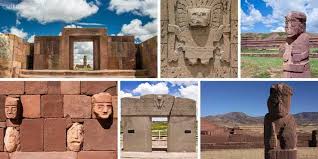Add your promotional text...
The Tiahuanaco culture
The Tiahuanaco culture, also known as Tiwanaku, was a pre-Inca civilization that flourished in the Andean region, centered on Lake Titicaca, between 1580 BC and 1187 AD. Its origins date back to a small farming and fishing village that, thanks to the domestication of the llama and trade, expanded across a vast territory that today includes parts of Bolivia, Peru, Chile, and Argentina. Development and Characteristics: Location: It developed mainly on the Collao plateau, on the shores of Lake Titicaca, at an altitude of approximately 3,900 meters above sea level. Economy: Based on agriculture, including advanced techniques such as raised terraces and raised fields (sukakollos) for growing potatoes and quinoa, and livestock, especially llamas. Political Organization: A theocratic society, with a hierarchical structure that included the elite, artisans, and peasants. Architecture: Recognized for their impressive constructions, such as the Kalasasaya Temple, the Akapana Pyramid, and the Sun Gate, with decorative elements such as reliefs and incised planes. Ceramics and Art: They developed distinctive ceramics, including the famous queros (ceremonial vessels) and huaco-portraits (facial representations on vessels), as well as textiles and metalwork. Religion: They worshipped the god Wiracocha, represented on the Sun Gate, and Tunupa, an Andean deity. Influence: Their influence extended to other Andean cultures, including the Inca, who adopted some of their agricultural techniques and architectural elements. Decline: The cause of their decline, which occurred gradually over a period of about 200 years, is unknown, but speculation is linked to climate change and internal tensions. Tiahuanaco in History: The Tiahuanaco culture is considered one of the most important pre-Inca civilizations in the Central Andes. Its capital city, Tiahuanaco, was an important ceremonial and administrative center, with a great influence in the region. The ruins of Tiahuanaco are a testament to its greatness and are considered a UNESCO World Heritage Site. The Tiahuanaco culture left a significant legacy in the architecture, ceramics, textiles, and religion of the Andean region.
8/6/20251 min read


Contenido de mi publicación
